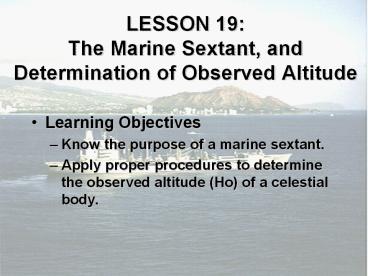LESSON%2019:%20The%20Marine%20Sextant,%20and%20Determination%20of%20Observed%20Altitude - PowerPoint PPT Presentation
Title:
LESSON%2019:%20The%20Marine%20Sextant,%20and%20Determination%20of%20Observed%20Altitude
Description:
a celestial body (star, sun, moon, or planet) the visible horizon. Use of the Sextant. A sextant is used to determine the sextant altitude (hs) of a celestial body. ... – PowerPoint PPT presentation
Number of Views:589
Avg rating:3.0/5.0
Title: LESSON%2019:%20The%20Marine%20Sextant,%20and%20Determination%20of%20Observed%20Altitude
1
LESSON 19The Marine Sextant, and Determination
of Observed Altitude
- Learning Objectives
- Know the purpose of a marine sextant.
- Apply proper procedures to determine the observed
altitude (Ho) of a celestial body.
2
The Marine Sextant
- A marine sextant is nothing more than a device
designed to measure, with a great deal of
precision, the angle between two objects. - In celestial navigation, these objects are
- a celestial body (star, sun, moon, or planet)
- the visible horizon.
3
(No Transcript)
4
Use of the Sextant
- A sextant is used to determine the sextant
altitude (hs) of a celestial body. - First, we have to decide which stars to observe
this is done using a Rude Starfinder or other
methods. - When making an observation, the star should look
as shown in the next slide...
5
(No Transcript)
6
Determination of Observed Altitude (Ho)
- We must make some corrections to hs to come up
with the Ho, which we need to use the
altitude-intercept method.
7
Determination of Observed Altitude (Ho)
- These corrections account for the following
- index error (error in the sextant itself)
- difference between visible and celestial horizon,
due to the observers height of eye - adjustment to the equivalent reading at the
center of the earth and the center of the body - refractive effects of the earths atmosphere
8
Determination of Ho
- The corrections needed to convert from the
sextant altitude (hs) to observed altitude (Ho)
are - 1. Index Correction (IC) - sextant error
- 2. Dip (D) - height of eye
- 3. Altitude Correction (Alt Corr) -refractive
effects of the atmosphere
9
1. Index Correction (IC)
- Error present in the sextant itself is known as
index error (IC). - This error is easily determined by setting the
sextant to zero and observing the horizon if
there is no error, the view looks like that of
the following slide...
10
(No Transcript)
11
Index Correction
- Often, however, the sextant has a slight error.
In this case, the view is as follows
12
(No Transcript)
13
Index Correction
- To account for this sextant error, we apply an
index correction (IC). - This correction number is a function of the
individual sextant itself.
14
2. Dip Correction (D)
- Next, we must account for the difference between
the celestial horizon and the visible horizon,
due to our height of eye. - This is known as the dip correction (D).
- Values of the dip correction are tabulated inside
the front cover of the Nautical Almanac.
15
(No Transcript)
16
Apparent Altitude
- Now, by applying the index correction (IC) and
the dip correction (D), we can determine the
apparent altitude (ha). - ha hs IC D
- Note that this is not yet the observed altitude
(Ho) required for our calculations.
17
3. Altitude Correction
- The third correction accounts for the refractive
effects of the earths atmosphere. - Known as the altitude correction, it is tabulated
inside the front cover of the Nautical Almanac. - Ho ha Alt Corr
18
Altitude Correction
19
Determination of Ho
- Again, the corrections needed to convert from the
sextant altitude (hs) to observed altitude (Ho)
were - IC (index correction, from sextant error)
- D (dip, from height of eye)
- Alt Corr (altitude correction, from refractive
effects)
20
Additional Corrections
- These corrections are all that are needed under
normal circumstances to determine Ho of a star. - An additional correction is required if the
observation is made under non-standard conditions
of temperature or pressure.
21
Additional Corrections
- If we are using the sun, moon, or planets, the
problem becomes a bit more complicated. - In addition to the corrections we already
mentioned, we must also accout for - horizontal parallax (sun, moon, Venus, Mars)
- semidiameter of the body (sun and moon)
- augmentation (moon)
22
Additional Corrections
- These additional corrections make determination
of Ho for the sun, moon, and planets generally
more difficult than those for a star. - For simplicitys sake, well stick to
determination of Ho for a star.
23
Use of a Strip Chart
- To aid in making any calculations in celestial
navigation, we normally use a form called a strip
chart. - An example of a strip chart used for calculating
Ho of Dubhe is shown on the next slide...
24
(No Transcript)





























